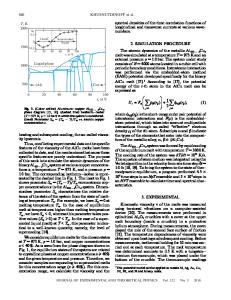Nucleation Effects in Thermally Managed Graphite Fiber-Reinforced Al-Cu and Al-Si Composites
- PDF / 896,447 Bytes
- 9 Pages / 593.972 x 792 pts Page_size
- 0 Downloads / 307 Views
DIFICATION processes, including pressure infiltration, are commonly employed in ex-situ processing of metal matrix composites (MMCs). In cast particulate or fiber-reinforced MMCs, the microstructural features of the exhibited solidification structures are significantly influenced by the type and volume fraction of reinforcements, as well as the melt chemistry. In addition, the resultant morphologies are strongly dependent on processing parameters such as cooling rates and fiber preheating temperatures. In particular, the solidification structure of matrix alloy is closely related to the role of the reinforcements as effective nucleation substrates for the primary phase. This, in turn, is intimately linked to the catalytic nucleation potency of the reinforcement surfaces[1] when compared with the one associated with the active melt impurities. Accordingly, preferred nucleation along reinforcements is expected to be dominant when the effective wetting angle, hf, is smaller than the one corresponding to the active impurity substrates, hs, at a given undercooling, as described by H.G. SEONG, formerly Graduate Student, Materials Department, University of Wisconsin–Milwaukee, is with The I-Cube Center, Gyeongsang National University, Gazwadong 900, Jinju, South Korea. H.F. LOPEZ, Professor and Chair, and P.K. ROHATGI, Professor, Materials Department, and M. GAJDARDZISKAJOSIFOVSKA, Professor, Physics Department, are with the University of Wisconsin–Milwaukee, Milwaukee, WI 53211. Contact e-mail: [email protected] Manuscript submitted May 1, 2006. Article published online September 15, 2007. 2796—VOLUME 38A, NOVEMBER 2007
hf 0), but small enough to promote heterogeneous nucleation. In the present work, only a few a-Al/a-Al interfaces were observed and usually associated with disruptions in the continuity of the fiber reinforcements. Apparently, external heat extraction by direct fiber cooling was highly effective in promoting preferential nucleation of single a-Al envelopes around the GRFs. The development of a single solidified layer, as inferred by the observations of this work, suggests the lack of a significant barrier for the nucleation of a-Al on the GRF surfaces. When the GRFs are externally cooled during melt infiltration, the nucleation barrier for a-Al is no longer relevant (hf = 0 in Eq. [1]). In other words, the relatively low fiber surface temperatures combined with the relatively high rates of heat extraction through the fiber reinforcements promote total fiber wettability by the surrounding melt. 2800—VOLUME 38A, NOVEMBER 2007
The role of relatively low fiber temperatures on the pressure infiltration kinetics has been considered by Mortensen and co-workers.[18–20] In their work, they assume that a uniform solidified layer develops around the fiber interfaces due to their relatively low surface temperatures. The development of a solid layer can lead to closure of interfiber channels stopping metal flow. Hence, their proposed model can be used to estimate optimal fiber preform temperatures in order to avoid full solidification of the fiber
Data Loading...











